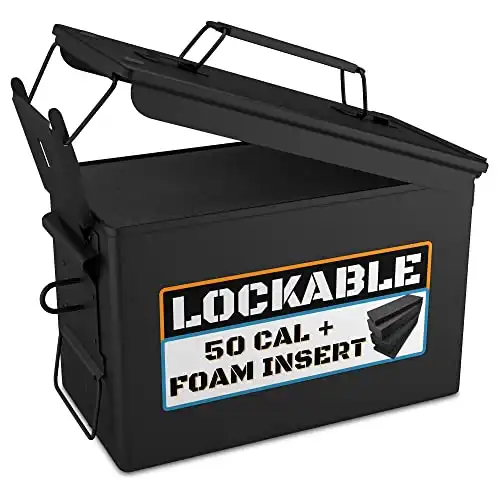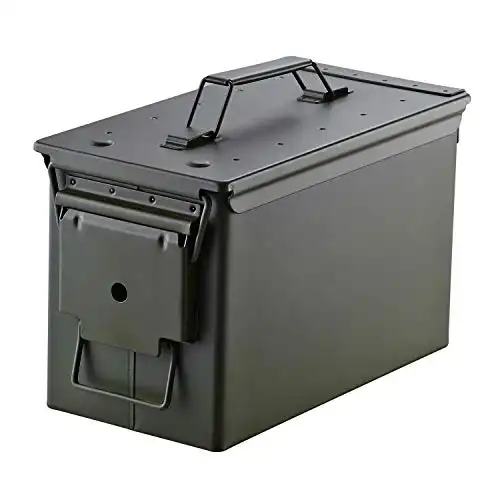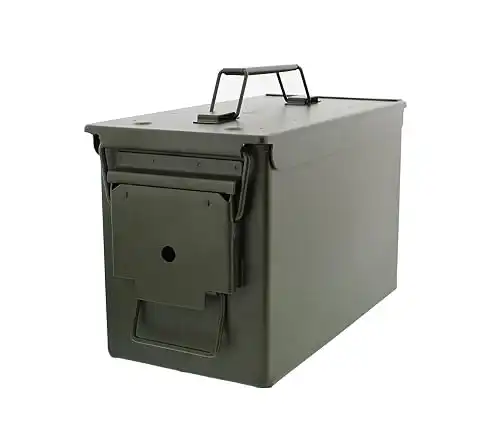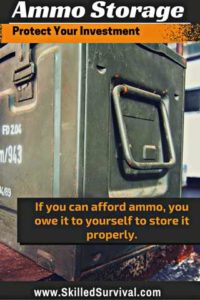
A Complete Guide On Storing Your Ammo
Because if you have ammo, you owe it to yourself to store it properly.
You should treat your ammunition like precious metals.
Both require good storage practices to maintain them for the long haul.
If you don’t, it’s shelf life (and accuracy) will be cut short.
This would be a travesty.
Because ammo is a critical tool in any emergency.
TOPICS IN THIS GUIDE… ↓(click to jump)
- Does Ammo Go Bad?
- Old Ammo Vs. New Ammo
- How To Store Ammo The Right Way
- Best Ammo Cans For Sale
- Humidity Control and Desiccants
- Your Long-Term Storage Plan
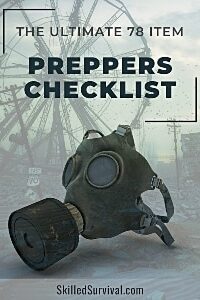
Want a free 78 item preppers checklist?
Enter your email below to instantly download this Complete Checklist PDF. No purchase necessary. 👇 👇Does Ammo Go Bad?
Yes, ammo DOES have an expiration date.
But unlike food, which has a shelf life measured in weeks, ammo is measured in decades.
But it all depends on HOW you store it.
If stored right, it can outlive YOU.
Heck, it may even outlive your kids and grandkids.
Modern ammo can last centuries.
But if you store your ammo improperly, degradation starts day one.
Slow at first, but useless in just a few years.
And even IF it still fires, I wont’ be accurate.
↓ Does Ammo Go Bad | Accuracy?

Want a free 78 item prepper checklist?
Enter your email below to instantly download this Complete Checklist PDF. No purchase necessary. 👇 👇Old Ammo Vs. New Ammo
Modern materials, designs, and manufacturing have improved the shelf life of ammo.
And that’s great news for those who stockpile.
When discussing “older ammo,” I’m primarily referencing ammo manufactured after the 1930s.
Back when smokeless powder was introduced.
↓ Black Powder Vs. Smokeless Powder
Older bullets had a much shorter shelf life unless meticulously stored.
Today, the risk vs. reward of shooting older ammo may not be worth it.
And the equation keeps getting worse as each year passes.
↓ Will These 90-Year-Old .22 Rounds Still Function?
The bottom line is:
Your ammo stockpile is an investment.
You want to protect this investment as long as possible.
So let’s learn how to do just that:
How To Store Ammo The Right Way
Proper storage for ammo is not complicated.
You only need to follow some simple principles and take action.
Yes, that’s it.
Here’s the first storage principle:
Store your ammunition in a cool, dry, dark location.
Let’s break that down.
If you keep your ammo in a…
- Cool
- Dry
- Dark
…place, you win.
Follow this, and you’ll extend your ammunition stockpile from decades to centuries.
Once we analyzing this principle, we discover there’s a bit more to it.
So let’s dive deep into each:
↓ How To Safely Store Ammunition
Keeping Your Ammo Cool
You want to keep your ammunition cool.
Not cold but cool.
Avoid warm or hot storage locations.
Constant warm temps or consistently cool temps are not the main concern.
It’s the temperature swings that are the real problem.
The integrity of ammo is compromised if it’s subjected to extreme temperature cycles.
It’s hard on ammo to go from 100 degrees to 0 degrees and back to 100 degrees, year after year.
Why is this bad?
These temperature swings invite humidity.
And as we’ll discuss shortly, humid environments are a serious threat to ammunition.
That’s why garages, attics, unheated cabins, and the trunk of your car are poor locations.
These storage locations are susceptible to extreme heat and cold swings.
- In winter, overnight temps can reach sub-zero degrees in garages, attics, etc.
- And in the summer, north of 100 F.
Ammo stored in such locations will seem fine for the first few years…
But if left in these locations over several decades, the temperature swings will begin taking a toll.
So, where should your ammo be stored?
Basements are popular.
Why? Because basements are located below ground level.
Ground temperatures change less than air temperatures.
So while air temps will change from 0 degrees to 100 degrees seasonally, ground temps 10 feet below the surface tend to stay in a range of 20 degrees.
So, for example:
If soil temps 10 feet underground average 50 degrees, it may rise to 60 degrees in the summer and drop to 40 degrees in winter.
This is significantly less variation than air temps.
And at 30 feet below the surface, temperature swings become negligible.
At this depth, ground temps stay constant regardless of the air temps.
So we can take advantage of the earth and support the “constant cool” principle.
That’s why basements are popular ammo storage locations but they can have downsides too.
Which we’ll cover next…
Keeping Ammo Dry
Moisture is even more dangerous to your ammunition than temperature swings.
Moisture is corrosive to metal.
And ammo is made of metal (brass casings, primers, and bullets).
Hence, moisture exposure will eventually rust your ammo.
It will begin with small amounts of surface rust.
You can sand this off, and it will still fire…
But even this may affect its accuracy.
And if this rust is allowed to fester, it will eventually (over several decades) render your ammunition useless.
So we need to control moisture.
But guess which part of our homes tends to have the highest humidity levels?
You’ve probably guessed it…
Basements.
Rain soaks into the ground.
Ground contacts your home’s foundation.
This ground moisture is dangerous to foundations if allowed to accumulate.
Make sure your gutters and downspouts are working properly.
It’s important to avoid foundation problems (i.e., leaks, cracking, settling, heaving, etc.)
Many homes have sump pumps to help manage basement moisture issues.
When massive flooding occurs, which area gets wet first?
Your basement.
So from a moisture standpoint, basements present a problem.
However, there are solutions to help manage these risks.
First, if you’re storing ammo in a basement, don’t set it on the floor.
Keep it in cabinets or racks.
The higher, the better.
That way, if your basement floods, your stockpile will remain above the water level.
Another way to manage the increased humidity in the basement air is to get a good dehumidifier.
This dehumidifier unit will continuously pull moisture out of a damp basement.
You also should remove the ammo from the orgnial boxes.
Why? Because there are trace amounts of moisture in that carboard.
And if you put your ammo in ammo cans (and you should) the air tight containers will pull that moisture out.
Instead, get them away from cardboard and into an ammo can.
Keeping Your Ammo “In the Dark”
UV light is also a destructive force.
Over long periods of exposure, the sun’s harmful UV rays will break down nearly everything.
You’ve seen this process with vehicles.
Leaving a vehicle in the sun for years deteriorates its exterior.
Compare THAT vehicle to one stored in a garage.
Over a long time, UV rays will take a similar toll.
The good news is:
Most indoor storage areas work just fine.
A closet, pantry, and basement are all protected from UV rays.
Plus, the inside of your ammo cans will be dark as well.
So if you store your cans in a windowless location, UV rays become a non-issue.
Organization Matters…A Lot
Good storage takes organization and discipline.
Remember, you’re stockpiling for decades.
So it’s important to stay organized and maintain control of the inventory.
It’s not ‘set and forget.’
You must maintain a process.
↓ How I Organize My Ammo Cans | MTM Ammo Cans
First, you should label your ammo cans (more on these below).
You want to be able to identify what’s in the can without opening it.
Labels allow you to inventory your stockpile and save time in an emergency.
If you need ammo for your 22 survival rifle, you want to avoid dumping it all out just to find which one has your 22 LRs.
So get yourself a quality labeler.
A labeler is one of my favorite prepping tools.
It comes in handy for more than just your ammo.
It’s also a perfect tool for food stockpiles and rotation practices.
It also helps keep my gear and survival supplies organized.
I also label key areas of my home for emergencies.
I’ve labeled the main water and natural gas shut-off valves.
As the head of the household, I know how to find and shut these off in emergencies.
I can’t assume I’ll be available when emergencies happen.
And for my family, it’s less intuitive.
But by adding labels, it’s easier to walk them through the process and find them in an emergency.
Worth every penny for my peace of mind.
Next, create a desiccant check schedule.
Every few months, open up each and check your desiccants (more on these below).
Create an email reminder, write it on a calendar, and check your stockpile regularly.
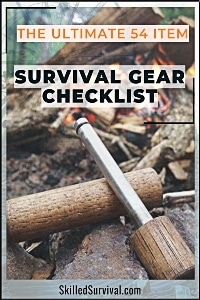
Want a free 54 item survival gear checklist?
Enter your email below to instantly download this Complete Checklist PDF. No purchase necessary. 👇 👇Best Ammo Cans On The Market Today
The third way to manage humidity is storing your ammo in cans.
But check the rubber gaskets.
Ensure they’re in good shape and create an airtight seal when latched.
That’s why I steer clear of used ammo cans.
I don’t trust used seals.
They are often dried out and cracked.
It’s not worth the risk.
Fresh seals ensure an airtight seal.
Quality cans will completely isolate the internal air from the external air.
I also tend to steer clear of plastic ones:
↓ Ammo Box Plastic Vs. Steel…
Ok, let’s review a few of the best ammo cans on the market:
↓ Solid Tactical 50 Caliber & 30 Caliber Ammo Can
This metal can features a “WORRY-FREE SEAL” that's air and watertight.
It comes with a hinged lid with a locking latch.
And a flat-folding handle.
It’s built to last with it's heavy gauge solid steel.
It comes in classic camo green color (.30 caliber or .50 caliber), tan color (.50 caliber only), or black color (.50 caliber only).
Here’s a helpful comment from one reviewer:
"Here's what I consider the biggest advantage of this container. I stored loose ammunition in this can, and also in plastic ammo cans made by Plano and MTM. The plastic cans had rubber seals around the inside of the lid. So I assumed they would keep out moisture from humid air. I placed desiccant packs in all the containers.... the kind of desiccants that have beads that go from blue (when dry) to pink (when saturated). The desiccants in the plastic ammo boxes turned pink in less than two weeks. However, the desiccants in this metal can were still blue in the same period. For this reason alone, not to mention the superior strength of the Redneck can... I’m buying more metal cans to store all my ammo."
One concern is the stack-ability of these.
The carry handle creates a small “void” on the bottom of each can that’s slightly off-center.
This causes a very high stack of them to slant…
And just for fun, here are 25 survival uses for ammo cans!
↓ Why Buy Ammo Cans?
Want a free 78 item prepper checklist?
Enter your email below to instantly download this Complete Checklist PDF. No purchase necessary. 👇 👇More About Desiccants
Good ammo cans keep the air inside the can from co-mingling with outside air.
This allows for complete control over the air inside the can.
That way, you have humidity control.
How so? Using something called a desiccant.
Toss a few desiccants into each, and they’ll remove the moisture.
Silica Gel Packets use particle physics (osmosis) to attract moisture particles.
The air inside will remain dry by trapping the moisture in the desiccant.
So the surrounding ammo can air that touches your ammo will be arid.
And as we discussed earlier, moisture is what causes metals to corrode.
So by removing moisture, you eliminate corrosion.
It’s simple math:
- No moisture equals no rust.
- No rust equals no corrosion.
- And eliminating corrosion extends your ammo’s shelf life, reliability, and accuracy.
In this process, you’ll occasionally need to recharge your desiccants.
I like these desiccants for four reasons.
1. First, they’re designed for up to a 3-square-foot area.
Three square feet is more than enough for a regular-sized ammo can.
I can standardize on one desiccant style and size for all my needs.
I prefer to use universal parts and components whenever possible.
It’s always a headache to use several styles of desiccants and keep track of them all.
No thanks.
2. Second, they include a color code.
If you see an orange, they are still doing their job.
If it’s clear, it’s time to recharge them.
This color coding makes it simple.
Open your ammo can, look at the desiccant color, note the clear ones, and replace as needed.
Easy peasy.
3. Third, they are rechargeable.
They pull moisture from the air continuously until they “fill up.”
At some point, the desiccant are full and can no longer draw more moisture from the air.
Why? Because it’s reached its moisture capacity.
That’s when the color turns clear.
But they are not ‘one and done.’
You get to reuse them over and over again.
Just reset these desiccants in an oven at 300 degrees for 3 hours.
So these desiccants are a wise choice and worth every penny.
4. Fourth, they don’t use cancer-causing chemicals.
They don’t use the nasty chemical Cobalt Chloride.
This chemical has become classified as Group 2B, which states Cobalt Chloride is possibly carcinogenic.
No way I’m handling a carcinogen and putting them in my oven.
With these desiccants, you never have to worry about that.
Want a free 78 item prepper checklist?
Enter your email below to instantly download this Complete Checklist PDF. No purchase necessary. 👇 👇Ammo Storage Action Plan
1. Decide on a cool, dry, dark, and safe location.
Put some thought into your storage location.
The best advice is where NOT to store your ammo.
Don’t store your ammo in:
- An unheated/cooled garage
- An unheated/cooled attic
- Your vehicle
- OR the original boxes
2. Purchase high-quality ammo cans.
I recommend you dedicate each caliber to its own can.
Don’t mix and match.
Then label each can so you know what’s inside without opening it.
↓ How Much 9mm Fits Into An Ammo Can?
3. Add fresh desiccants to each can.
4. Create a master schedule to check your desiccants.
Then replace and recharge as necessary.
See, that wasn’t so hard!
Here’s a short video overview of your ammo storage plan:
↓ Ammunition Storage 101
And finally, a responsible gun owner should have a large gun safe.
Well…it may be a good place to put your ammo as well.
Everything is double secure from intruders, fires, or curious kids.
Final Thoughts
Remember, in a long-term emergency, he who has the most firepower; wins.
That’s why, ammo is arguably THE most important item you can stockpile.
It provides the ability to hunt, barter, defend your home, intimidate others, concealed carry, etc.
But to rely on these survival tactics, you must:
- Purchase a large quantities of ammo
- Have properly stored ammunition
It’s obvious, but worth saying,
A firearm is just a shitty baseball bat without ammunition.
Why Trust Skilled Survival...
Go here now to review a full breakdown of:
- Who We Are
- Our Credentials
- Our Mission
- & Product Recommendations...
Here are a few highlights of our teams credentials & certifications:
- Certified Member of a Mountain Search & Rescue Organization
- Plant Emergency & Safety Leader for a Major Food Manufacturer
- Member of the 10TH Mountain Division Hut Association
- Certifications: Avalanche 1, WFR, CPR
- Official Gear Tester for Numerous Outdoor Gear Companies
- Countless Multiday Backpacking trips into Remote Wilderness
- Bachelor's Degree In Mechanical Engineering
- Bachelor's Degree In Civil Engineering
- Bachelor's Degree In Biomedical Engineering
"It takes 20 years to build a reputation and five minutes to ruin it." - Warren Buffett
We're fully aware that trust is NOT something you GET but is EARNED.
And we'll continue to earn YOUR trust through our forthright and honest approach with each new Blog Post, Guide & Product we create...
Prepare, Adapt & Overcome,

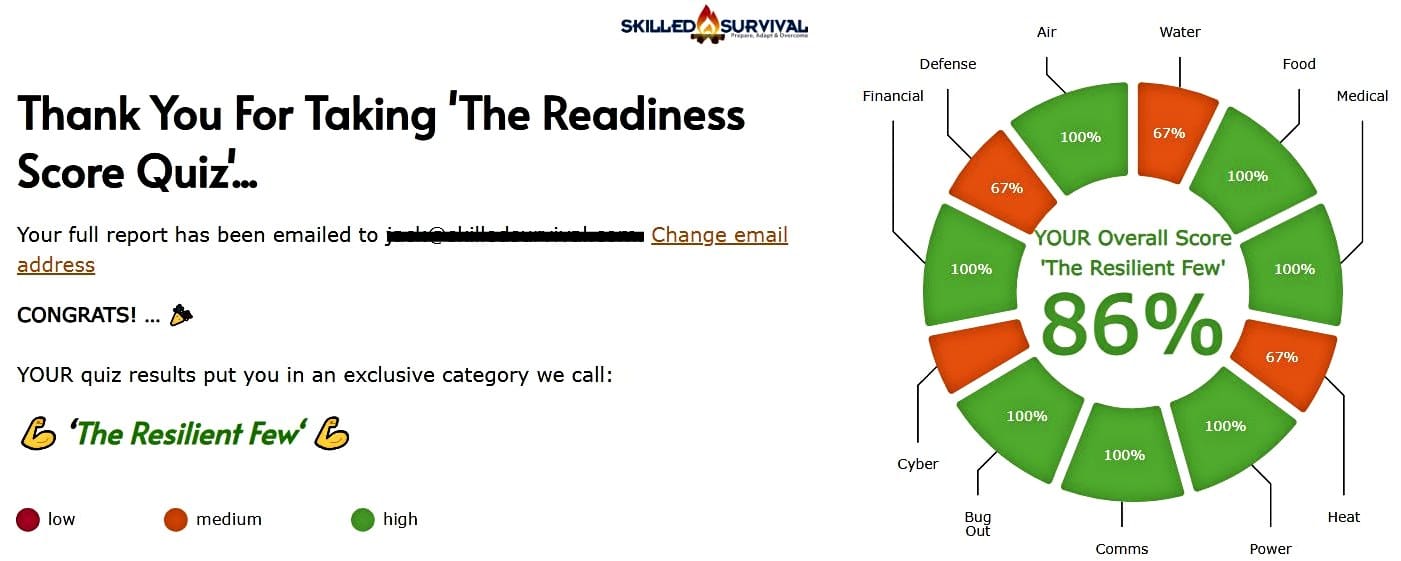
AND... I've still got a few gaps in my preps...🤔 But at least, I'm not part of 'The Fragile Masses'. 👍 Find out where YOU stand by answering a few questions...

Recommended Reading
Best Fuel Storage Ideas: How To Store Extra Gasoline
Long term fuel storage is crucial in all survival situations, but fuels must be stored properly and safely to keep, especially long term gasoline storage.
How To Store Seeds For Wise Prepping & Survival
When seed saving and seed storage, you must do it right. Learn how to store seeds so they'll thrive the next planting season.
Common Everyday Carry Mistakes YOU Must Avoid At All Costs
The only person qualified to build YOUR Best Everyday Carry (EDC) is YOU. To do it right, you must avoid these common mistakes and pitfalls.
Strategic Relocation: How To Find A Safe Pace To Live
Use strategic relocation to find a safe, defendable location to call home. Your choice of location WILL determine your survival fate.
Map Of Nuclear Fallout: Would I Survive A Nuclear Bomb?
Have you seen a map of nuclear fallout? Or run a nuclear simulation to see the damage a nuke would do to your city? If not, check this out.
Homestead Survival: How To Master Plan Your Own Safe Haven
Use this simple 6 step action plan to successfully plan and build a homestead to survive (and thrive) even if the world falls into chaos...



